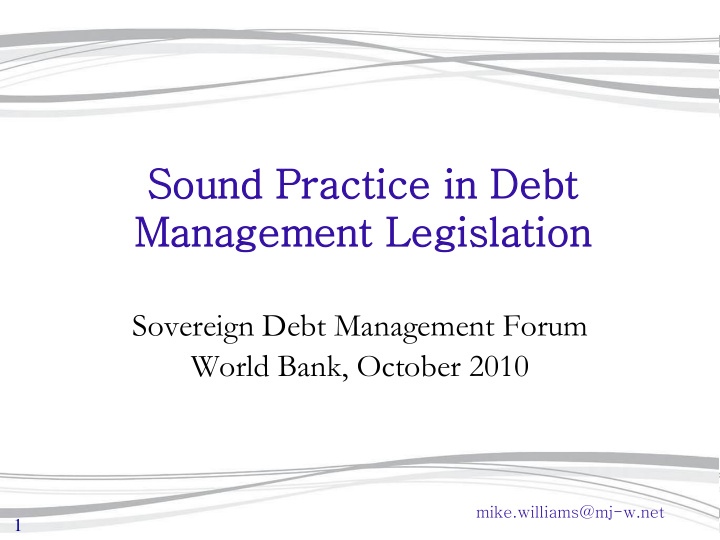



Sound Practice in in Debt t Management Legis islation Sovereign Debt Management Forum World Bank, October 2010 mike.williams@mj-w.net 1
The Institutional Context • Legislation is only one component of the governance structure – but a key one – Defines and focuses powers, but also limits abuses and establishes accountabilities • But legislation reflects institutional needs and practices of countries concerned – Common law v. civil law – huge difference in extent of codification – How far are ministers’ and officials’ roles and responsibilities specified in legislaiton, or are they allowed discretion (but are accountable for its exercise)? – Varying boundary between primary and secondary legislation mike.williams@mj-w.net 2
Some Trade-offs • Allow for innovation in financial markets – Several debt managers currently unable to use swaps – Constraints on e.g. dematerialisation of securities • Debt managers need to be flexible and responsive • Argues for reliance on professionalism and accountability within high level regulatory framework • But – Depends on administrative background and history, and relationship between executive and parliament – In LICs a well defined framework may strengthen debt managers in relation to capricious politicians mike.williams@mj-w.net 3
The Essential Requirements • Specify authority to borrow, also give guarantees etc – Allowing for delegation to the executive – Identify sole borrowing authority, i.e. Minister of Finance, and Minister’s powers, potentially allowing delegation to officials • Issues of scope: central or general government or public sector • Specify borrowing purposes (defined broadly) • Set clear high-level debt management objectives • Require preparation (and publication) of debt management strategy • Priority appropriation for debt interest – In some English-speaking countries, inc in Constitution, but law is sufficient • Identify mandatory reporting and audit requirements • Range of other issues, eg – Roles of other institutions and the relationship with other governmental bodies: e.g. central bank; establishing a DMO or a Public Debt Committee – Cash management powers mike.williams@mj-w.net 4
Some Tric icky Issues – Parliament • Strongly recommended that parliamentary control does not extend to individual borrowing decisions – Adds a potentially cumbersome, time-consuming and over-politicised step in decision-making process – Time is often of the essence for market borrowing • More appropriate for parliament to approve the legislation and hold ministers and officials accountable for the debt management strategy and its execution • Instead reassure Parliament – Sound legislation and a strong governance framework with clear objective- setting, borrowing authority, reporting, accountability and audit provisions – Provide an opportunity to discuss the debt strategy, e.g. as part of the annual budget discussions, and to vote on the annual borrowing resolution • Compromises – Less problematic for loans and credits [may also be covered by treaties] – Approve parameters of a borrowing programme mike.williams@mj-w.net 5
Some Tric icky Issues – Borrowing Lim imits • Limits or targets in primary legislation (e.g. debt/GDP – as for eurozone supplicants who include Maastricht’s 60%) rarely make sense – If too low they may constrain responses at the time of financial stress, given the time lags involved in passing new legislation. – If too high, they may not be meaningful. • If they are to be included, must be: – Realistic – and accepted as such – Underpinned by adequate political commitment, with appropriate compliance mechanisms in place • Preference: – An annual borrowing limit set consistently with the financing requirement implied by the annual budget – Ideally flows from debt strategy and annual financing plan – Limit would be specified in the annual budget law or resolution. • May not be exactly the same as the financing requirement, some flexibility needed • Update if budget updated mike.williams@mj-w.net 6
The Legislative Vehic icle • Wide range: constitution, fiscal responsibility act (FRA), budget act, financial administration act, etc • Preference for integrated debt management act – improves coherence and accountability • Some areas of overlap – Annual net borrowing limit may be set under budget law – FRA covers different issues than a GDMA • FRA’s focus is fiscal policy: may include path for debt • Borrowing limits better in FRA not GDMA • Both should include accountability reporting • Use secondary legislation for operational and potentially ephemeral issues mike.williams@mj-w.net 7
Recommend
More recommend